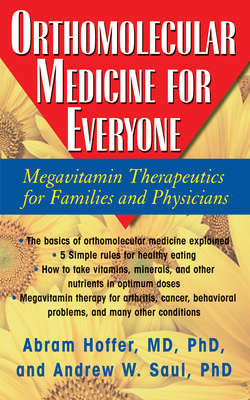Читать книгу Orthomolecular Medicine for Everyone - Abram Hoffer M.D. Ph.D. - Страница 61
TAKING VITAMIN B3
ОглавлениеOrthomolecular therapists use vitamin B3 in large doses, because for many diseases the usual vitamin doses are totally inadequate. Each condition requires its optimum dose, which varies from 1,000 mg to many grams per day. It is usually given in three divided doses, for it is water-soluble and quickly eliminated from the body.
Niacin almost always causes a pronounced flush when it is first taken. This is probably due to the sudden release of histamine. The flush or vasodilatation is remarkably similar to the one that follows the injection of histamine, with one major difference—a histamine injection lowers blood pressure, while the niacin flush does not. The current hypothesis is that prostaglandins are also involved, fueled by the observation that aspirin decreases the intensity of the niacin flush. We suspect that both mechanisms may play a role.
The flush starts in the forehead and face and works its way down. Sometimes the whole body—down to the toes—turns red, but this is rare. During the flush, the person’s face and body turn red and feel itchy and hot. After an hour or so, the flush slowly disappears. The first flush is usually the worst. With each dose thereafter, there is less and less flush, and in most cases it is almost gone after a few weeks. If the dose is too low, flushing may remain a problem. Each person has a minimum dose that must be exceeded before flushing ceases, usually 1,000 mg taken three times a day.
The intensity of the flush depends upon the subject’s state of niacin saturation and upon the rapidity of absorption. To minimize the flush, one reduces the rate of absorption by taking the vitamin after meals so it will be diluted by food. Flushing can be increased by dissolving the niacin in hot water and drinking it on an empty stomach. Slow-release preparations markedly reduce the intensity of the flush and are preferred by many. The flush is not harmful, but patients must be warned to expect it or they may become fearful. A few people even enjoy the flush and try to regain it by stopping their niacin for a few days. When they resume taking it, the sequence of decreasing flushes is again experienced.
Esters of niacin, such as Linodil (a preparation of inositol and niacin), are generally free of this flushing action because the niacin is released so slowly that the flush threshold in the body is not exceeded. The intensity of the flush can also be reduced by using either antihistamines, aspirin, or both, either before or at the same time that the niacin is taken.36 There is no flush with niacinamide in 99 out of 100 people. Perhaps the rare person who flushes on niacinamide may be able to convert it very rapidly into niacin.
The optimum dose of vitamin B3 is the quantity that will cure the person in the absence of side effects. The usual side effect is nausea and later vomiting. If the stage of nausea is reached, the dose must be reduced. If vomiting starts, the vitamin should be stopped for a couple of days and then started at a lower dose. Both forms of vitamin B3 are available in 250 mg, 500 mg, and 1,000 mg tablets or capsules. The usual starting dose for adults is 1,000 mg three times per day after meals. This may be increased if the therapeutic response is too slow, until side effects occur. If at 6,000 mg per day there is nausea, the dose should be reduced to 5,000 mg or 4,000 mg per day. With niacinamide, the nausea-producing dose is lower than for niacin. It is seldom possible to go as high as 9,000 mg per day for niacinamide. For niacin, the nauseant dose may be extremely high—a few subjects have taken 60 g per day with no nausea. When the nauseant dose is low for both forms, both may be needed to reach a therapeutic level of total B3.
Vitamin B3 is a remarkably safe therapeutic substance, even when taken with no medical supervision. With adequate medical supervision, it is completely safe. Vitamin B3 is considered to be nontoxic by orthomolecular therapists. In decades of widespread high-dose use, there have been only one or two deaths attributed to B3 overdose, and no alleged fatalities have been confirmed.
